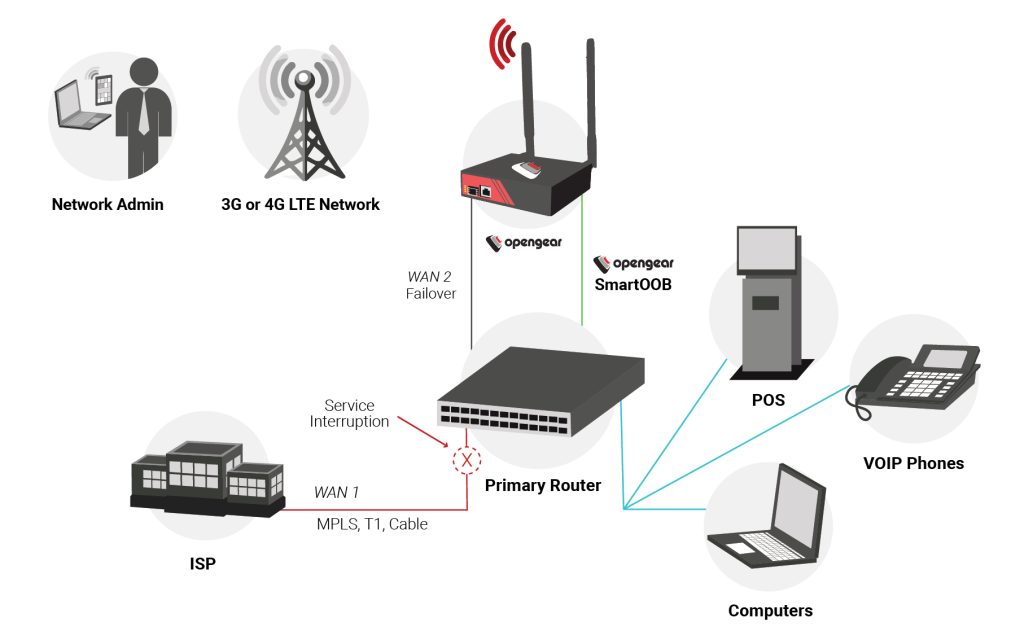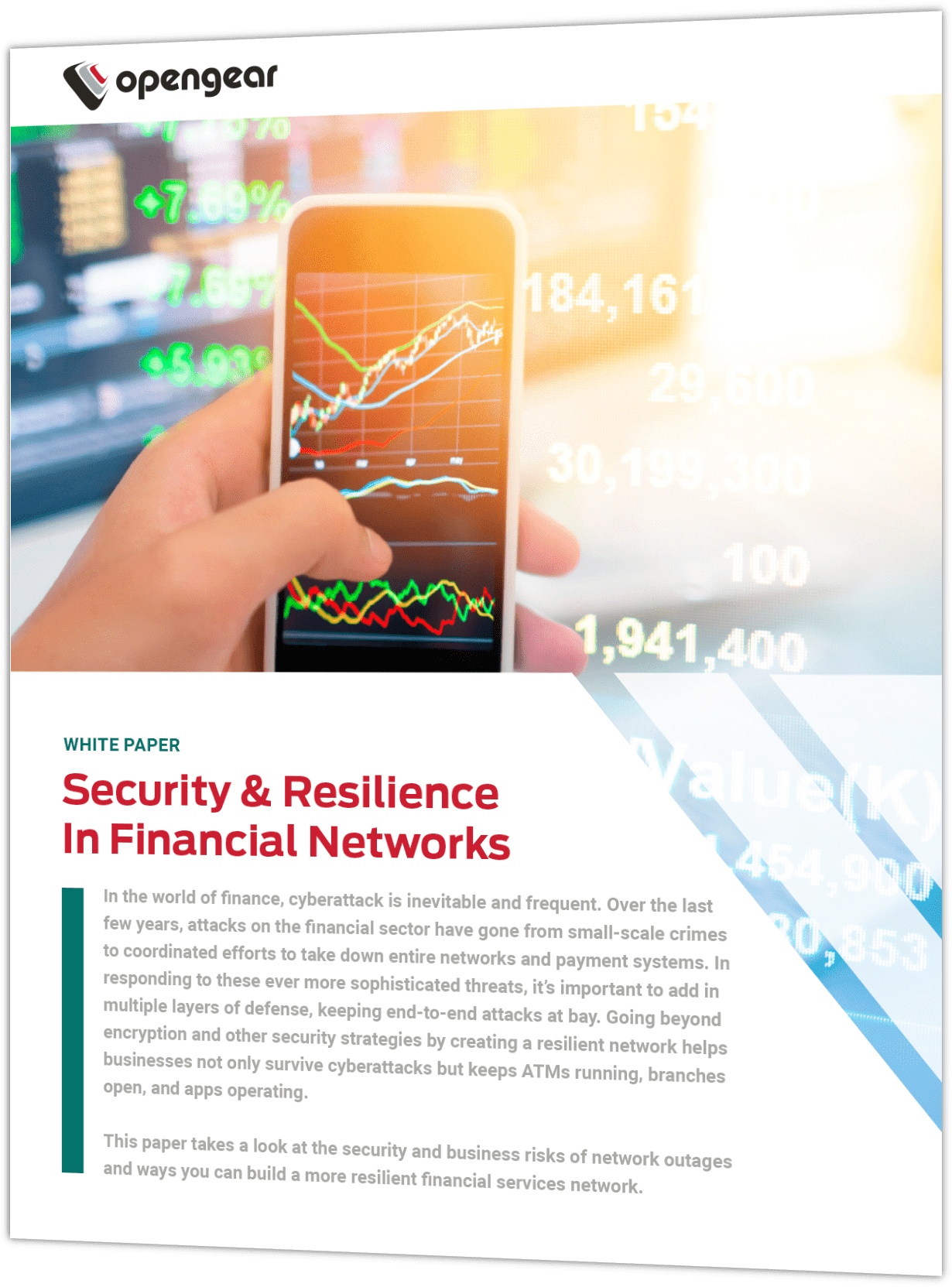Blog Archives
Failover to Cellular
Enable always-on availability
Opengear Failover to Cellular™ (F2C) provides continued internet connectivity for remote LANs and equipment over high-speed 4G LTE or 3G networks when the primary link is unavailable. Ensuring speed to keep the network running smoothly and link diversity for true WAN resilience, Failover to Cellular is built on robust IP Passthrough technology. This allows for easy integration into existing installs or can be rapidly deployed for instant-on connectivity for new networks and branch locations.
This feature is useful for an SD-WAN deployment. SD-WAN enables organizations to reduce costs and maintain secure network connections, however the high bandwidth internet connections, routers and constant firmware updates associated with this can introduce a single point of failure. If the network goes down during a deployment, Smart OOB™ and Failover to Cellular ensures secondary access to the routers to easily reflash or power cycle. NetOps staff are able to remotely get the network backup and running without an onsite visit.
READ CASE STUDY
Increase resilience and remediation
Failover to Cellular allows organizations to maintain connectivity and decrease disruption with ensured business continuity. Easily integrating with existing IT systems and network infrastructure, F2C restores WAN connectivity without manual intervention. Utilized with Smart Out-of-Band (Smart OOB), which is built into all Opengear devices, organizations are able to have remote access even when WAN and LAN networks are down. During an outage, in order to remediate the problem as quickly as possible, network engineers must have visibility of the whole network. Smart OOB provides engineers with full visibility to maximize uptime and reduce outages.
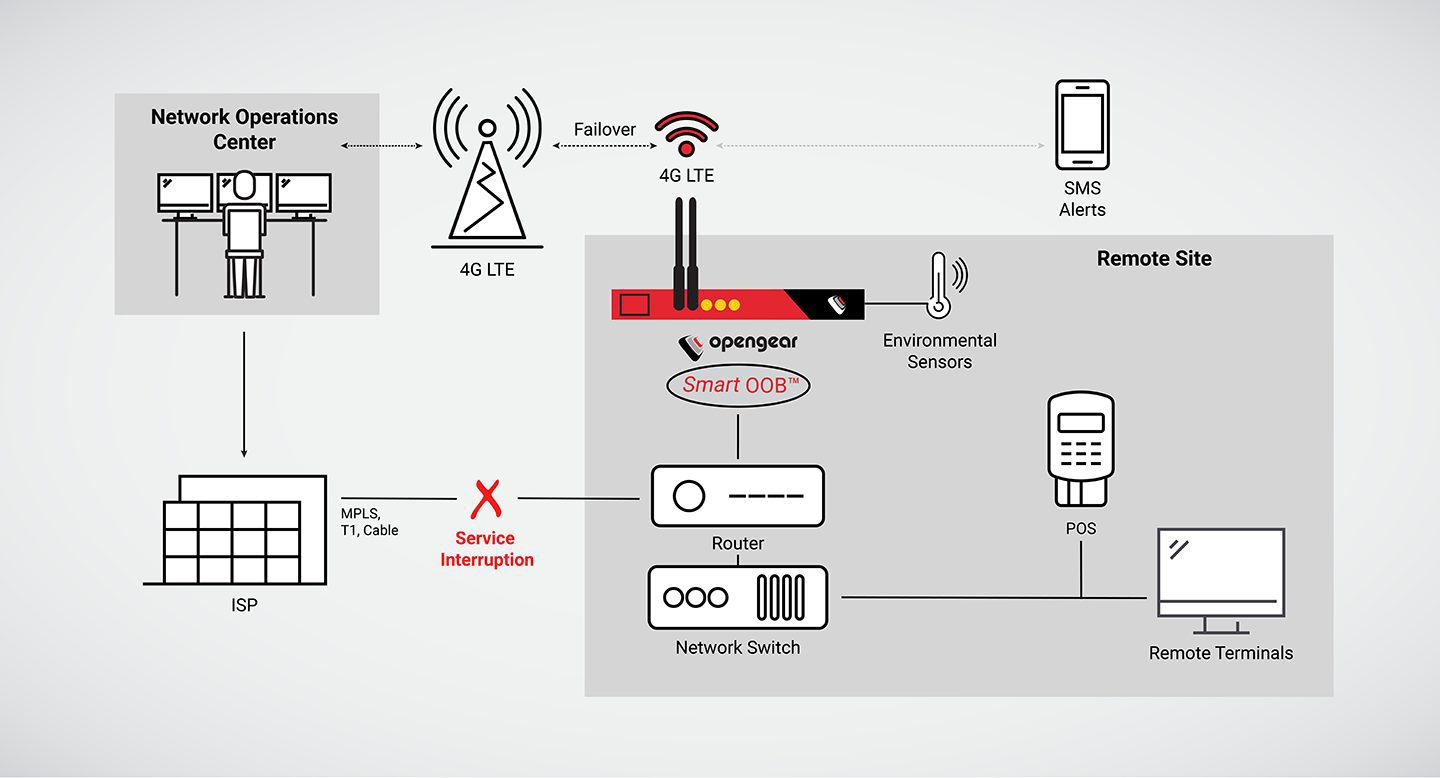
Remediate issues remotely
Distributed enterprises often times may experience disruption events that effect the primary network connection. Failover to Cellular built-in to Opengear devices, automatically activate a secondary connection to re-establish in and outbound network access. Once failover is enabled, Opengear devices are able to detect failures sending ICMP ping requests from the primary network interface to a primary and secondary probe address remotely. If these requests fail – the primary connection has been deemed as having also failed. When the primary connection has been restored, the devices automatically fail forward and resumes normal operation.
Quickline
Swiss full service provider Quickline introduces new out-of-band management with failover to cellular backup for centralised management of IT infrastructures
The comprehensive service offered by Quickline Group, with its head office in Nidau in the canton of Berne, covers internet, telephony and digital TV through to digital workspace and business cloud hosting. So for Quickline, ensuring seamless network connectivity for business continuity was absolutely critical. The company has been using out-of-band management since 2008 for permanent monitoring and remote maintenance of critical IT infrastructures in its data centres and remote sites and ensuring high availability, even if the primary in-band network were to fail.
“Because our networks are distributed all over the country, reliable remote access to critical infrastructure devices is essential for our support staff so we can act immediately and precisely and resolve possible faults remotely and as quickly as possible”, explains Simon Koch, Head of Network Operation, Quickline. “The quality of our customer service is of prime importance for us. That is why we have been using OOB technology for the last ten years across all of our business divisions. However, the time had come to replace our previous OOB solution, which only offered a conventional modem-failover connection, with a state-of-the-art solution.”
Latest generation OOB solution with high-speed failover to cellular
As the second largest cable network provider in Switzerland we have a large number of sites scattered all over, even in the Alps. Since it’s difficult to get copper connections there, we were looking for an alternative which could also offer us an out-of-band management solution” Koch continues. “We looked at several manufacturers and finally decided on Opengear. The decisive factor was the integrated 4G solution for devices. Its functionality and the whole package with centralised software management met our needs exactly. That’s why we decided to replace our previous out-of-band management system generally with the new wireless OOB solution, with 12 or 48 serial ports at large sites and 4 ports at smaller sites.”
Implementation of the first 80 or so OOB devices began in autumn 2017. In addition to a conventional modem failover, the Opengear console servers offer an integrated solution via a high-speed cellular connection (3G/4G LTE). Opengear IM7200 OOB infrastructure managers are now being used for remote maintenance and proactive monitoring in Quickline’s data centres. Opengear ACM7000 resilience gateways are used for the points of presence (POPs) spread across the country; as compact solutions they are tailored to smaller remote sites.
“We are planning to change all our sites successively to 4G OOB technology” Michel Renfer, IT Manager Strategy & Network at Quickline, explains. “In the next three to five years we will probably upgrade a total of 200 to 300 sites.”
The integrated wireless option offered by the OOB console servers also scored highly in terms of operating costs:
“Apart from the hardware, another factor was that the costs for our previous out-of-band access system vis DSL weren’t scalable” Michael Renfer reveals. “As well as selecting a new OOB management system we have found a wireless access solution which is so much cheaper in terms of operating costs than the previous wired DSL access.”
Simon Koch adds “wireless give us much more flexibility because copper wires are no longer laid in many new sites, particularly in new buildings; they only use fibre optics which means that wired OOB access isn’t available anymore.”
Centralised management of the whole OOB infrastructure
“With the large number of sites that we have, a centralised management system with automatic configuration for simple scalability and device provisioning is very important. That’s why the new OOB solution had to have a software management platform” Simon Koch explains. “The new out-of-band management software tool allows our administrators to keep an eye on all installed OOB console managers and connected devices from a central location. In addition, new devices can be configured and provisioned very simply.”
Quickline is using Opengear’s Lighthouse OOB management software. As a central management platform for remote access gateways, the solution is implemented as a virtual software appliance and implements OpenVPN encrypted tunnels to gateways for all LAN, WAN and wireless remote access connections. Lighthouse can be installed on any VMWare sessions and also has a RESTful API interface, allowing the platform to be integrated easily in other management tools already installed.
Devices can be grouped according to users, sites or manufacturers, making for clear and simple management. The management software gives a status overview over all access gateways or nodes. Nodes are declared to the software tool and the process is simplified using enrollment bundles. These bundles combine a unique registration token with user-defined tags such as a geographical location, a department or even a rack position. In addition, specific strict access authorisation can also be defined.
Zero touch provisioning (ZTP): Rapid preconfiguration and provisioning
“Time-saving provisioning of devices was another factor in our decision” Simon Koch adds. “Our administrators use the management software to integrate new devices into the existing network structure quickly and without local intervention on site. They have the option to automate node configuration and the provisioning process for new devices.”
Once the console servers have been preconfigured, they only have to be hooked up on site (ZTP, zero touch provisioning). Several units are preconfigured at the same time. This reduces provisioning costs and sources of human error.
Out-of-band management means a fast and targeted response
“Out-of-band management helps our engineers enormously with general maintenance work on our backbone”, Michel Renfer explains. “If something isn’t working as it should, which can always happen, our technical staff can see immediately the status of the particular device. They can intervene directly without having to go on site. It is especially important to be informed at all times of the status of devices, for example, when we are carrying out maintenance work on a core router, such as a software update. Since in-band connectivity is interrupted at times, which is inevitable, we can monitor the status of devices permanently out-of-band.”
Around one year after introducing the new out-of-band management solution, the view at Quickline is positive throughout. Simon Koch sums up:
“We are very satisfied with the new OOB solution, particularly since we can avoid on-site intervention which means considerable savings in time and hence costs. We can reduce unnecessary downtime, guarantee quality support for our customers and we can act quickly and precisely to resolve any network failures or technical issues. And should a visit on-site be necessary at any point, our support staff can use the OOB remote maintenance solution to identify in advance which spare part is needed.”
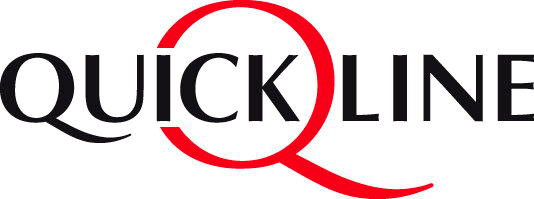
Entertainment
The Quickline Group is one of Switzerland’s leading full-service providers of communication and entertainment. The third largest TV provider and fourth largest internet provider in the country, the organization provides private customers, SMEs and network operators a wide range of products.
Digi International To Acquire Opengear
HOPKINS, Minn., November 7, 2019 – Digi International® Inc., (Nasdaq: DGII, www.digi.com), a leading global provider of Internet of Things (IoT) connectivity products, software and services today announced it has signed a definitive agreement to acquire Opengear, Inc., a provider of secure IT infrastructure products and software. The closing of the transaction is subject to customary conditions, including antitrust regulatory clearance.
Founded in 2004, Opengear delivers critical IT infrastructure, including failover-to-cellular and out-of-band management solutions, to a broad range of Fortune 100 and other customers. Its provisioning, orchestration and remote management of network devices, through innovative software and appliances, enables technical staff to manage their data centers and remote network locations. Opengear is headquartered in Edison, New Jersey, with R&D centers in Silicon Valley and Brisbane, Australia, with an additional office in Sandy, Utah. Opengear is expected to retain its existing office locations and future office consolidations, if any, will be designed to minimize disruption to employees and customers.
Digi has agreed to acquire Opengear for upfront cash of approximately $140 million with a potential for contingent consideration of up to an additional $15 million based on revenue performance through 2020. To finance the purchase, Digi expects to use a combination of cash on hand and debt financing under a $150 million facility that BMO Harris Bank N.A. has committed to provide to Digi. Canaccord Genuity served as financial advisor to Digi on the acquisition, Stephens Inc. advised Digi in obtaining the debt commitment, and Faegre Baker Daniels LLP served as legal counsel to Digi on the transactions. Digi expects the acquisition to be immediately accretive to earnings.
“Joining forces with Opengear gives customers an expansive, high-value, technology portfolio that is hardware enabled and software defined,” said Ron Konezny, President and CEO of Digi International. “Both companies have a deep commitment to our customers and will continue to invest in product development to deliver business- and mission-critical solutions.”
“Digi and Opengear will mesh well as we share so many of the same values in how we treat our customers and employees,” said Opengear CEO Gary Marks. “Our products are complementary, so customers and partners will get exceptional choice.”
An investor presentation pertaining to the acquisition can be found at the investor relations section of Digi’s website.
About Digi International
Digi International (Nasdaq: DGII) is a leading global provider of business and mission-critical Internet of Things (IoT) connectivity products and solutions. We help our customers create next-generation connected products and solutions to deploy, monitor and manage critical communications infrastructures and compliance standards in demanding environments with high levels of security, relentless reliability and bulletproof performance. Founded in 1985, we’ve helped our customers connect over 100 million things, and growing. Visit www.digi.com.
About Opengear
Opengear delivers secure, resilient access and automation to critical IT infrastructure, even when the network is down. Provisioning, orchestration and remote management of network devices, through innovative software and appliances, enables technical staff to manage their data centers and remote network locations reliably and efficiently. Opengear’s business continuity solutions are trusted by global organizations across financial, digital communications, retail and manufacturing industries. Visit www.opengear.com.
Forward-Looking Statement
This press release contains forward-looking statements that are based on management’s current expectations and assumptions. These statements often can be identified by the use of forward-looking terminology such as “anticipate,” “believe,” “estimate,” “may,” “will,” “expect,” “plan,” “project,” “should,” or “continue” or the negative thereof or other variations thereon or similar terminology. Among other items, these statements relate to expectations about the certainty and timing of completing the transactions, future business performance of the business expected to be purchased in the above described acquisition as well as future actions, operations and performance of Digi following the pending acquisition. Such statements are not guarantees of future performance and involve certain risks, uncertainties and assumptions, including risks related to satisfaction of the closing conditions, whether our business will perform as anticipated, our ability to integrate the acquired business effectively, the potential growth or entrance in the marketplace of competitors, some of whom may have significantly more resources than us, whether the intended target market for the products of the acquired business will adopt our offerings, whether we will be able to sell the products of the acquired business effectively into the marketplace, whether we will be able to leverage the product development and engineering resources of the acquired business effectively, rapid changes in technologies that may displace products and services we intend to sell, delays in product development efforts, uncertainty in user acceptance of our products and services, the ability to maintain key customer and vendor relationships of the acquired company, the ability to integrate our products and services with those of other parties in a commercially accepted manner, potential liabilities that can arise if any of our products have design or manufacturing defects, our ability to defend or settle satisfactorily any litigation, uncertainty in global economic conditions and economic conditions within particular regions of the world which could negatively affect product demand and the financial solvency of customers and suppliers, the impact of natural disasters and other events beyond our control that could negatively impact our supply chain and customers, our ability to attract and retain important employees, potential unintended consequences associated with restructuring or other similar business initiatives that may impact our ability to retain important employees and our ability to execute on the business to achieve the anticipated benefits and synergies associated with the transaction. These and other risks, uncertainties and assumptions identified from time to time in our filings with the United States Securities and Exchange Commission, including without limitation, our annual report on Form 10-K for the year ended September 30, 2018 and subsequent quarterly reports on Form 10-Q and other filings, could cause the Digi’s future results to differ materially from those expressed in any forward-looking statements made by us or on our behalf. Many of such factors are beyond our ability to control or predict. These forward-looking statements speak only as of the date for which they are made. We disclaim any intent or obligation to update any forward-looking statements, whether as a result of new information, future events or otherwise.
Media Contact:
Melinda Ball
LEWIS
Office: +1 781-418-2400
Digi@teamlewis.com
Investor Contact:
Jamie Loch
Digi International
Sr. Vice President, Chief Financial Officer, and Treasurer
+1 (952) 912-3737
Jamie.Loch@digi.com
Ensuring Always-On Availability for Distributed Healthcare Sites
Ensuring Always-On Availability for Distributed Healthcare Sites
One of the largest multinational pharmaceutical companies in the world needed a new Out-of-Band vendor. Constantly facing latency challenges, the organization needed to ensure always-on availability to its multiple distributed sites. Watch this video to learn how they’ve increased uptime, improved productivity and ensured network resilience.
To learn more about network resilience solutions for your healthcare organization, you can read our whitepaper today!
AWS, Centralized Backup, LDAP/S and More in Lighthouse 2019.Q3.0
 Opengear’s Lighthouse has reached another milestone. We now support all of the Big 3 cloud providers, adding AWS support in the latest release. With options for deploying all major Hypervisors and Amazon’s AWS, Microsoft’s Azure and and Google’s GCE you have options for how you deploy the smartest out-of-band management solution available today.
Opengear’s Lighthouse has reached another milestone. We now support all of the Big 3 cloud providers, adding AWS support in the latest release. With options for deploying all major Hypervisors and Amazon’s AWS, Microsoft’s Azure and and Google’s GCE you have options for how you deploy the smartest out-of-band management solution available today.
In addition to AWS support, Lighthouse 2019.Q3.0 introduces the ability to centrally manage backups for all of your connected Opengear Nodes as well as secure LDAP/S communication.
Find out all the details here and get your copy today.
Network Resilience for Financial Companies
The boom in network technology has come with its share of benefits and challenges for finance companies. More customers are choosing to do their banking online, and transactions and stock trades occur in milliseconds. These advancements have made banking easier and spurred growth for financial companies, but they’ve also introduced critical vulnerabilities and network challenges. Challenges that finance companies need to address in order to maintain their credibility, comply with regulations, and keep their competitive edge.
- Network challenges specific to Financial companies
- What is Smart Out-of-Band and how does it fit as a solution?
- Case studies from financial companies deploying Smart Out-of-band

Dylan Schafer
Regional Sales Manager, South Region
WATCH THIS WEBINAR
SD-WAN Deployments in Finance
There has been a widespread move towards SD-WAN in the financial sector. An industry that embraced features such as online banking and mobile apps, is continuing the tech forward mindset by using technology to improve network performance, communications and speed. IoT and mobile devices are just a few applications that have increased customer expectations and to continue to meet these, financial institutions must build their online engagement model. As more are added to the network, performance can suffer and onsite technicians distributed sites are few and far between. Providing improved security, reliability and performance, SD-WAN ensures a more streamlined solution with less need for a technician onsite. Additional benefits of SD-WAN for financial institutions include:
Bandwidth Optimization
More than 36% of organizations have chosen to move to SD-WAN because of the optimization of bandwidth.1 Providing the ability to utilize a variety of connectivity options, most jump at the chance to eliminate expensive MPLS circuits, it continually searches for the best path as it carries packets across the network. This is an immediate benefit, as other most other solutions have little capability to actually prioritize the data being carried.
This allows financial organizations to use lower priced bandwidth products, without sacrificing quality or consistency. It also provides consistent communications – with the amount of transactions being processed in finance this is a necessity. Now these organizations like credit unions and banks, with distributed locations, can also switch to lower data packages allowing them to reduce costs and improve communications.
WAN Integration
Finance has a variety of business distribution models – each with challenging network needs. Requiring an always-on network, any small disruptions can quickly escalate. In fact, 28% of organizations indicate that the ability to use existing architecture in an aging network is a major concern. SD-WAN provides organizations with greater control over solution used across each network.
Automation at Distributed Sites
Financial institutions have distributed locations and without the proper solution, functioning as a cohesive unit can be a challenge and if not properly managed, it can become a source of operational and financial inefficiency. This makes SD-WAN a perfect fit for these distributed organizations. More than 28% of organizations state a need for improved automation and self provisioning for their network.2 This would allow financial institutions to manage and view the WAN as one entity, instead of treating each endpoint as a standalone resource.
SD-WAN has a variety of benefits, but it does have points of failure. To learn about adding Smart Out-of-Band to your next deployment for always-on access, see our storygraphic.
1 https://www.idc.com/getdoc.jsp?containerId=prUS44203118
2 https://virtualizationreview.com/articles/2018/10/25/sd–wan-survey.aspx
Network resilience from core to edge in financial networks
Network resilience from core to edge in financial networks
Learn how one of the top performing banks in the United States utilized Opengear smart solutions to decrease their downtime, reduce the need for site visits, and ensure compliance requirements are met.
To learn more about network resilience solutions for your financial organization, please download our whitepaper today!
White paper: Building Network Resilience
White paper: Building Network Resilience
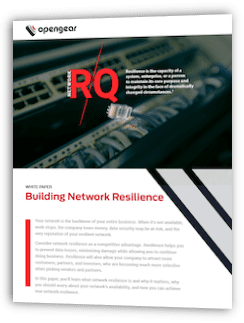
Network Resilience: Keeping the network running at the core and out to the edge of the infrastructure, with no disruption to the customer experience in the event of human error, external issues or hardware failures.
Network outages have a direct impact on an organization’s revenue, customer retention and brand. Network resilience plays an important role in ensuring business continuity. When the network is down, money can be lost, productivity can be stunted and data security can be at risk.
Achieve true network resilience, when an organization is able to maintain services, remove points of failure and has an understanding of how to bring the network back up during a disruption.
Download this white paper to learn:
- Why network resilience is important
- How to get support from top leadership
- The most important factors in building a resilient network
Achieving Network Resilience in Retail
Achieving Network Resilience in Retail
Keep the doors open and your retail locations running smoothly with a Smart Out-of-Band network.
The retail industry is relying more and more on network connectivity. Cash registers, ATMs, Inventory management systems, security, they all require a reliable network to work. A disruption can potentially prevent a store or branch office from functioning. Every minute a site remains offline can result in thousands of dollars in lost revenue, brand damage and dissatisfied customers. A Smart Out-of-band network is the insurance your retail network infrastructure needs to ensure it doesn’t skip a beat, even in the face of an outage.
- Challenges specific to retail networks
- What is Smart Out-of-Band and what is needed to deploy it
- Actual case studies from retail companies deploying Smart Out-of-band

Joe Valha
Director of Sales – West at Opengear
WATCH THIS WEBINAR
The Problem with POTS Lines
What’s IP-based, cost efficient and rapidly replacing Plain Old Telephone Service (POTS) infrastructure? That would be 4G LTE. Over the past few years, many organizations are moving towards deploying newer technologies like 4G LTE instead of legacy POTS lines to use for Out-of-Band (OOB) connectivity or site backup. Opengear has been on the front of the technology wave, providing embedded cellular as part of our Out-of-Band offering since 2010. We understand the ins and outs of this technology boom- like how LTE allows for Smart Out-of-Band™ (Smart OOB) to be easily implemented into any infrastructure with its reliable, fast and secure failover for wireless connections.
Using POTS Lines
Remember the 80’s and 90’s and those sweet sounds of modems training up to provide blazing fast connections of 38400 Baud? Now do you remember the disconnects during downloads, the no answers and the busy signals? These memories are starting to quickly become not so fond. Do you want to run your OOB emergency access to infrastructure like this? Most would say no. The truth is carriers want to move away from POTS due to the cost of maintaining copper lines. This cost is passed on to you if you happen to be in an area where you can still get a POTS line. Most office phone connections today are now VOIP and running POTS over VOIP can be challenging as well. All of the these have contributed to the decline of POTS usage, in fact, the U.S. Federal Communications Commission (FCC) is vying for POTS lines to transition to wireless connectivity – which most already seem to be doing. The National Health Center has projected that only 6% of the population are actually using POTS lines.1
Top 3 Reasons For the Replacing POTS Lines
- Maintenance: The Communication Workers of America reports that many phone companies aren’t consistently repairing phone lines due to the cost, which delays how quickly linemen are sent out on calls. It’s estimated that $13 billion is spent every year to maintain old telephone networks – and from that kind of investment the benefits gained in return aren’t notable.2 In fact, in 2018 carriers including Verizon and AT&T will no longer have to install or maintain existing POTS lines. This means that POTS lines services and maintenance prices, which already are high, may increase. The Internet Innovation Alliance (IIA) states that there’s disincentive for phone companies to spend on infrastructure.
- Inclement Weather: Rain, lightning strikes, snow and tornadoes, when inclement weather strikes, many times phone companies are left to try and quickly remediate the issue not knowing where to start when the damage is excessive. In just a matter of seconds, these weather events can take out a landline.
- Costs: When it comes to maintaining POTS lines it can become costly with all of the purchasing needed for onsite hardware, IT resources needed for reconfigures and power cycle modems that are not responding. On average, it can cost $50 to $100 per month to have one POTS line and keep in mind you need two, one calling line and one answering line. Anyone that has already invested in the infrastructure can head on over to POTS to cellular return on investment (ROI) calculator to see how cellular will pay for itself.
Failover to Cellular by Opengear
Opengear has made the most dependable console server which can be seen within the features of each device. Our console servers enable uninterrupted availability for remote networks utilizing 4G LTE for either OOB needs or failover needs and remediates network issues remotely by providing a cellular backup to small remote sites. Need more reasons to switch to cellular?
- Opengear’s IP interface is always available, but we also provide other options to have it deactivated by default and utilize SMS or Failover mechanisms for activation. This allows you to control when the IP address is reachable, eliminating unwanted guests. In addition, we also have a built-in firewall to allow you to tightly control who has access when the interface is active. Being an IP interface you can also monitor it with network tools ensuring maximum availability and visibility.
- It’s inexpensive! Carrier plans start as low as $5/month for 1 MB of data. That doesn’t sound like much in today’s world – but for OOB purposes, it’s a great start. Your average SSH session to a router console to issue some commands run from 200 to 400k worth of data! If you do need more data, you can raise the data plan to accommodate your needs. Below are some going rates for the major carriers in the US:
Don’t take our word for it, reach out to your carrier of choice and ask them about their Machine 2 Machine plans for IoT devices. If you do plan on using Opengear as a failover connection, you will need to choose a data rate plan accordingly because there is more data than just for OOB usage.
- Opengear devices provide both Out-of-Band and Failover to Cellular™ (F2C) capabilities. This allows you to not only use it for Out-of-Band, but also as a backup data circuit using the LTE interface as an internet connection, or if you add in IPSEC/VPN back to your main site, a backup link. This will allow your users to stay connected at remote locations if and when the primary WAN service were to go down.
Make your job easier. Don’t rely on antiquated modems and traditional lines as your troubleshoot, backup connection. Upgrade yourself to Opengear’s OOB and failover to increase your network’s resiliency using our embedded cellular technology. This means better availability, reliability, dependability monitoring and performance – all at a fraction of the cost of a POTS line connection.
To learn more about Smart Out-of-Band and F2C by Opengear, please watch our demo video.
1 https://www.compuvoip.com/the-end-of-the-pstn-2/
2 https://www.washingtonpost.com/news/the-switch/wp/2013/10/08/we-spend-billions-a-year-maintaining-phone-lines-almost-nobody-depends-on-should-we-get-rid-of-them/?utm_term=.420cc5dae515
Failover to Cellular™
Opengear’s Failover to Cellular™ solutions deliver always-on connectivity and resilience in the face of network failure events
- The cost of network disruption has never been higher, averaging more than $100k per hour for most industries
- No single wired connection can deliver 100% uptime. The question isn’t “whether” but “when” each of your remote sites will lose connectivity
- Failover to Cellular eliminates downtime with transparent failover to high speed 4G LTE when your primary connection fails
- Combined with Opengear SmartOOB™ for out-of-band management, Failover to Cellular (F2C) delivers high network availability and improved IT Resilience all in one single product.
Failover to Cellular (F2C) and Smart OOB
- Continuously monitors and alerts you to potential problems before they disrupt your network
- Automatically initiates action in response to defined events and remediates common network issues
- Provides always-on out-of-band access to maintain and restore critical infrastructure
- The result is increased MTBF and reduced MTTR from disruption — and a significantly more resilient network
